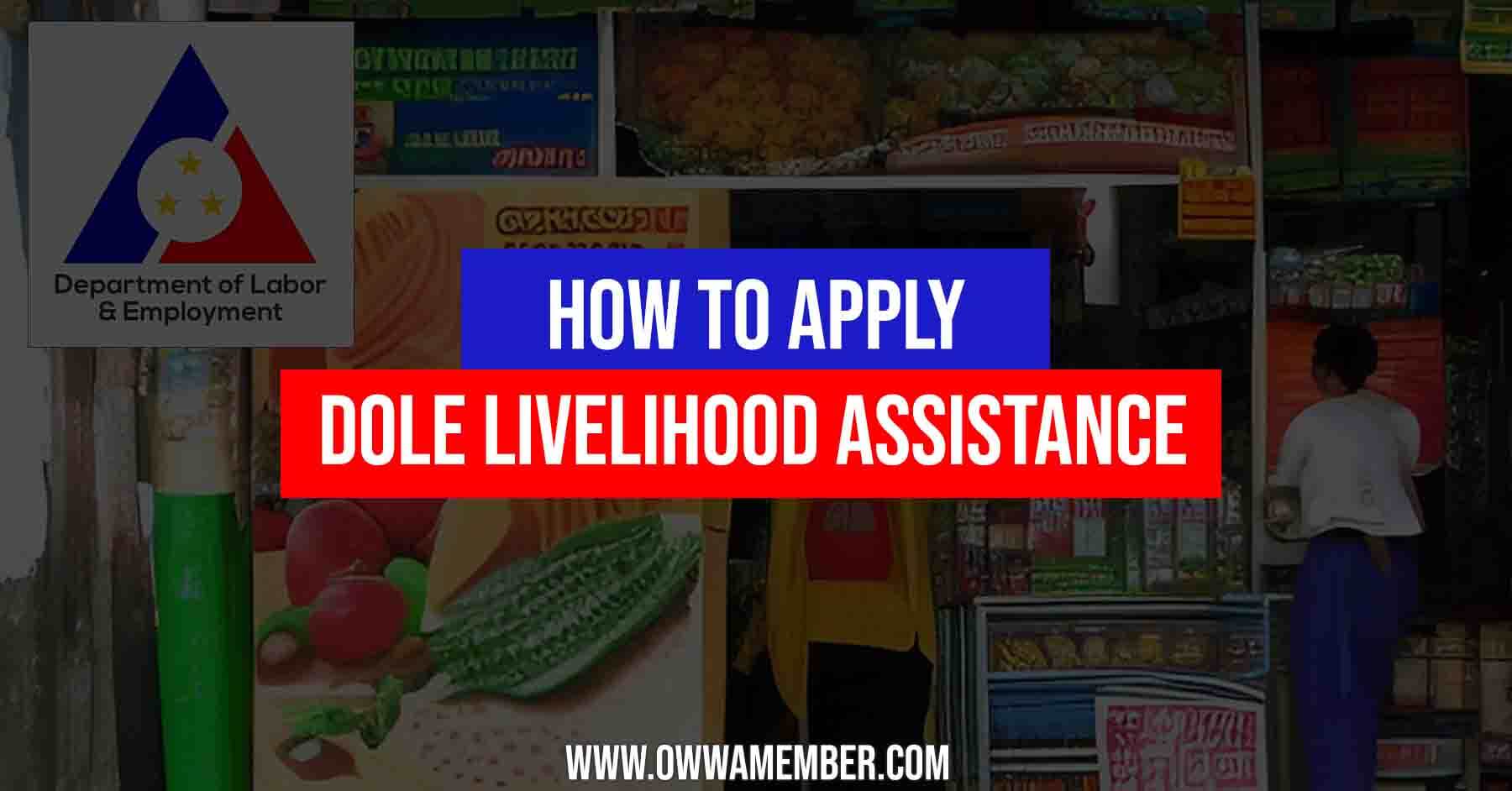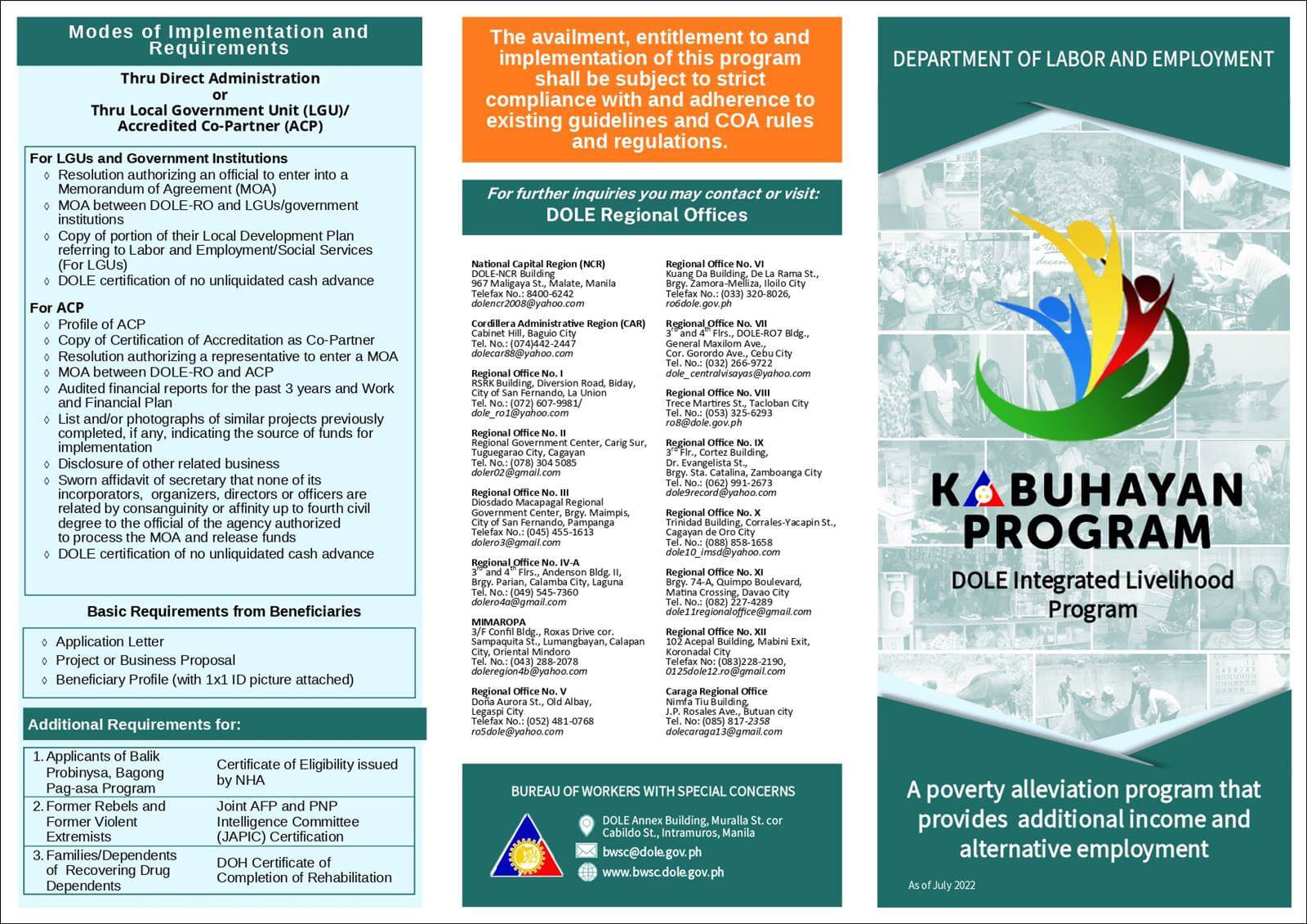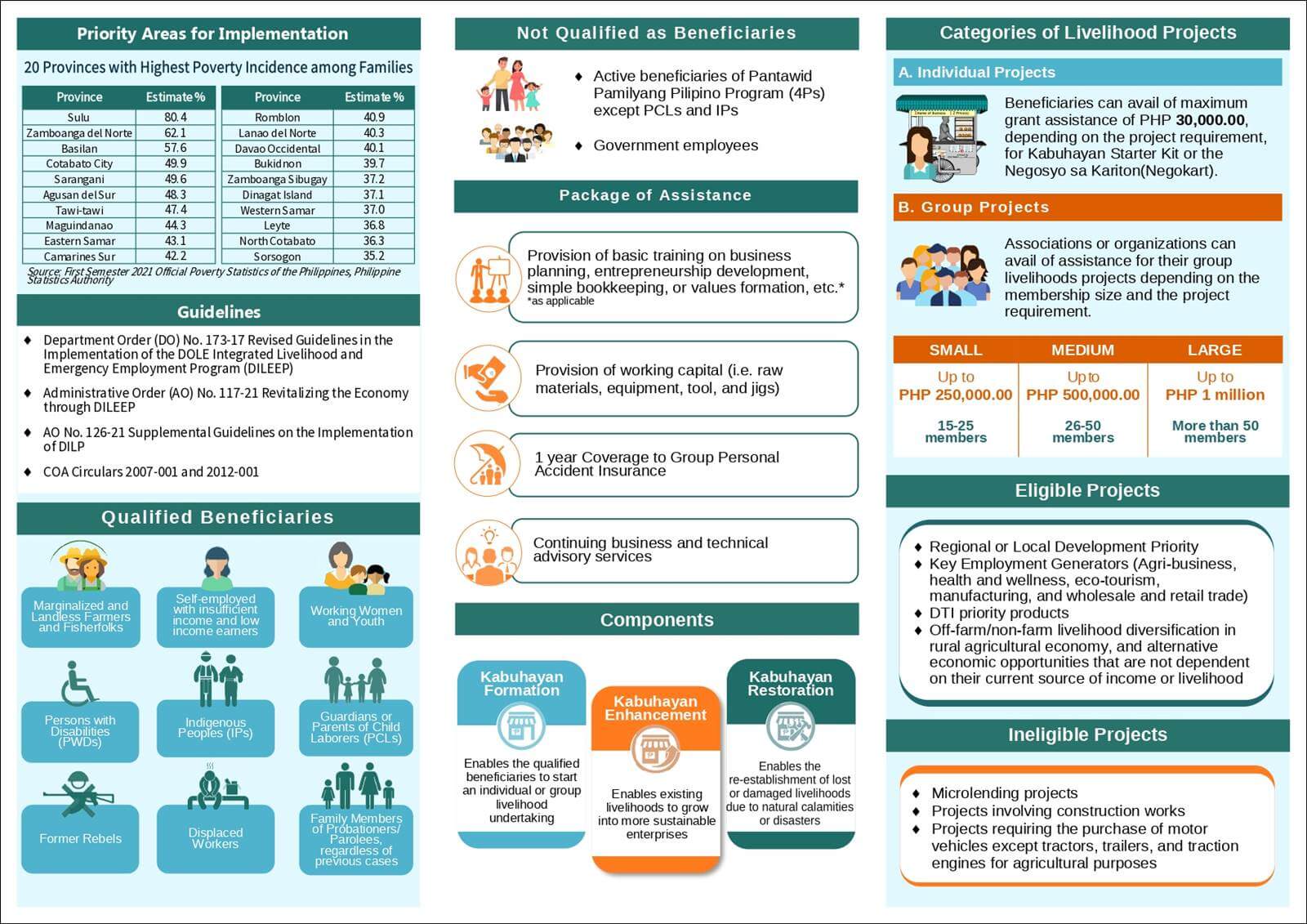The DILP (DOLE Integrated Livelihood Program) or Kabuhayan Program is the contribution of the Department of Labor and Employment (DOLE) to the government’s agenda for inclusive growth through significant poverty reduction and job growth. It aims to lessen the risk exposure of poor, vulnerable, and marginalized workers by granting them access to assistance for capacity-building on livelihood ventures.
Also Read: How to Apply HEROES Loan Program for OFWs
The DOLE Regional Offices directly administer the DILP or work with an accredited co-partner to do so (ACP). The following groups are eligible to be accredited as co-partners under this plan:
- Cooperatives
- Higher Educational Institutions
- Local Government Units (LGUs)
- National Technical-Vocational Schools
- National Government Agencies
- People’s Organizations
- State Universities and Colleges
- Unions or Federations
- Workers’ Associations
Contents
- Objective
- Qualifications
- Requirements
- Livelihood projects Eligible for Assistance
- Qualified beneficiaries of the Program
- Categorization of Livelihood Projects
- How to Apply DOLE Loan Assistance (DILP or KABUHAYAN)
- Video: DOLE XI Key Frontline Service: Livelihood Program (Filipino Version)
- Frequently Asked Questions (FAQs)
- Summary

Objective
To contribute to poverty reduction and reduce the vulnerability to risks of the poor, vulnerable, and marginalized workers.
Qualifications
The following individuals are qualified to process the livelihood loan assistance.
- Displaced (OFWs / migrant workers) or to be displaced workers as a result of natural disasters or closure of establishment, retrenchment, or termination
- Indigenous people
- Low or minimum-wage earners
- Marginalized workers (Fisher folks and landless farmers)
- Parents of child laborers
- Person with disability
- Rebel returnees
- Seasonal workers
- Self-employed with insufficient income
- Senior Citizen
- Unpaid Family workers
- Victims of armed conflicts
- Vulnerable
- Women and youth
On the other hand, the following are not eligible to the Program:
- Anyone Receiving Honorarium from the Government
- Beneficiaries of Pantawid Pamilyang Pilipino Program (4Ps)
- Elected Government Officials
- Government Employees – including those at the Local Government Units (LGUs)
Requirements
The following must be submitted to the closest DOLE Regional, Provincial, or Field Offices in order to be eligible for livelihood assistance:
- Letter of Intent addressed to the DOLE Regional Director
- All required documentation in accordance with the DILEEP guidelines:
- Beneficiary profiles with 1×1 ID picture attached
- Business plans or project proposals that have been approved and signed by the organization’s officers, etc.
- Work plans
For Local Government Units (LGUs) and Government Institutions
- Copy of portion of their Local Development Plan referring to Labor and Employment/Social Services (For LGUs)
- DOLE certification of no unliquidated cash advance
- MOA between DOLE-RO and LGUs/government institutions
- Resolution authorizing an official to enter into a Memorandum of Agreement (MOA)
For Accredited Co-Partner (ACP)
- Audited financial reports for the past 3 years and Work and Financial Plan
- Copy of Certification of Accreditation as Co-Partner
- Disclosure of other related business
- DOLE certification of no unliquidated cash advance
- List and/or photographs of similar projects previously completed, if any, indicating the source of funds for implementation
- MOA between DOLE-RO and ACP
- Profile of ACP
- Resolution authorizing a representative to enter a MOA
- Sworn affidavit of secretary that none of its incorporators, organizers, directors or officers are related by consanguinity or affinity up to fourth civil degree to the official of the agency authorized to process the MOA and release funds
Livelihood projects Eligible for Assistance
The livelihood / kabuhayan projects listed below are those that the Regional Development Council (RDC) and Regional Development Plan of Local Government Units (LGUs) have prioritized:
Priority Projects
- Agribusiness
- Eco-Tourism
- Health and Wellness
- Local based Industries as indicated in the Local Development Plan
- Manufacturing
- Small Transport
- Wholesale and Retail Trade
DTI Priority Products
- Cacao
- Coffee
- Coco-coir
On the other hand, the following projects are not eligible for assistance:
- Micro-lending projects
- Projects with construction works
- Projects that would require the purchase of motor vehicles, which mean any vehicle propelled by any power other than muscular power using the public highways
Qualified beneficiaries of the Program
The benefits of eligible beneficiaries of the Livelihood / Kabuhayan Program are listed below:
- Social security by enrolling in Group Personal Accident Insurance (GPAI) through GSIS, which will be paid for out of the overall project budget or as a counterpart to the Accredited Co-Partner (ACP)
- Training in production skills, entrepreneurship, business management, productivity, and business planning, as well as how to plan, set up, launch, and run a livelihood / kabuhayan project or currently undergoing.
- Ongoing business and technical consulting services to guarantee the effectiveness, productivity, and sustainability of the company or enterprise.
- Working capital for the acquirement of essential raw materials, machinery, tools, jigs, and support services
Categorization of Livelihood Projects
Individual Projects
Depending on the needs of the project, the beneficiaries may be eligible for the starter kit or Negosyo sa KAriton (Negosyo-Kart), which provides financial assistance up to a maximum of Php 30,000.00.
Group Projects
A project management team and profit-sharing strategy ought to be established for any organization managing a group project, and both should be outlined in the MOA and the business plan or proposal.
- Micro-Livelihood: Depending on the needs of the project, the organization, which has between 15 and 25 members, may receive up to Php 250,000.00 in financial assistance.
- Small Livelihood: Depending on the needs of the project, the organization, which has between 26 and 50 members, may receive up to Php 500,000 in financial assistance.
- Medium Livelihood: Depending on the needs of the project, the organization may receive up to Php 1,000,000.00 in financial assistance if it has more than 50 members.
How to Apply DOLE Loan Assistance (DILP or KABUHAYAN)
Follow these instructions to quickly apply for DOLE Loan Assistance:
Step 1: Prepare all the documentary requirements
Step 2: Go to the nearest DOLE Regional, Provincial, or Field Offices
Step 3: The DOLE Regional, Provincial, or Field Offices livelihood focal person will conduct orientation on DO 173-17 in coordination with Public Employment Service Office (PESO).
Step 4: Submit your Project Proposal for evaluation.
The focal person will immediately return the project proposal to the proponent or ACP with an endorsement letter if it is incomplete.
Step 5: The Provincial Project Management Team (PPMT) will conduct project proposal deliberation in coordination with the PESO and the proponent, to determine the project’s profile, minimum requirements, technical and financial evaluation, overall evaluation, and recommendation.
Step 6: After receiving all required documents, the field office head will endorse the project proposal after it has been evaluated and discussed, including all documentation needed for the Regional Project Management Team’s (RPMT) final consideration.
The RPMT will only conduct project proposal deliberation every 1st and 3rd Wednesday of the month or as scheduled by the RPMT Chairperson.
Step 7: Within three (3) working days following the completion of the RPMT, the RO-TSSD will inform the concerned field office of the status of the project proposal.
If rejected, the field office will comply with the noted inconsistencies or missing documents within five (5) working days of receiving the RPMT letter or findings.
Step 8: The RO-TSSD will endorse the project proposal with MOA for approval of the Regional Director within three (3) working days.
Step 9: Within three (3) working days, the RO-IMSD Accounting Unit will process the project proposal’s disbursement vouchers, and GSIS Insurance will prepare a check or an Advice to Debit Account (ADA).
Step 10: The Regional Director or Assistant Regional Director, the concerned field office head, the field office focal person, the Local Chief Executive, and PESO will all be present when the funding is released to the proponent/ACP.
Step 11: Implement the proposed project.
Step 12: The field officer will keep an eye on things and make sure the project is carried out sixty (60) days after the loan assistance is given to the beneficiaries.
Step 13: The RPMT will conduct monitoring of livelihood projects based on your Monthly Progress Report.


Video: DOLE XI Key Frontline Service: Livelihood Program (Filipino Version)
Watch the detailed video below about the Livelihood (Kabuhayan) Program. All DOLE offices have the same requirements, qualifications, and application process.
Frequently Asked Questions (FAQs)
If you have any further questions regarding “How to Apply DOLE Loan Assistance (DILP or KABUHAYAN)” see the list of frequently asked questions and answers below.
1. What is Kabuhayan or DOLE DILP?
The DOLE’s flagship program, DILP, or the Kabuhayan Program, helps marginalized groups like self-employed individuals who are unable to make a living wage, unpaid family members, low-wage and seasonal workers, displaced or about to be displaced workers, and marginalized and landless farmers.
2. What are the benefits of DOLE DILP or Kabuhayan?
The Livelihood Program was developed to help highly vulnerable households move into sustainable livelihoods and toward economic stability as well as to help poor households gain employment.
3. How much is the DOLE livelihood program loan assistance?
Loan assistance may vary depending on the project plan and the number of members:
- Starter kit or Negosyo sa KAriton (Negosyo-Kart) – up to a maximum of Php 30,000.00
- Micro-Livelihood – Which has between 15 and 25 members and may receive up to Php 250,000.00
- Small Livelihood – Which has between 26 and 50 members and may receive up to Php 500,000
- Medium Livelihood – Which has more than 60 members and may receive up to Php 1,000,000.00
4. How do I apply for DOLE livelihood loan assistance?
To be eligible for the livelihood loan assistance, you must submit the following documents to the DOLE Regional, Provincial, or Field Office that is closest to you:
- Letter of Intent addressed to the DOLE Regional Director
- All required documentation in accordance with the DILEEP guidelines:
- Beneficiary profiles with 1×1 ID picture attached
- Business plans or project proposals that have been approved and signed by the organization’s officers, etc.
- Work plans
5. What are the projects that I can apply to?
Priority Projects
- Agribusiness
- Eco-Tourism
- Health and Wellness
- Local based Industries as indicated in the Local Development Plan
- Manufacturing
- Small Transport
- Wholesale and Retail Trade
DTI Priority Products
- Cacao
- Coffee
- Coco-coir
Summary
To help marginalized groups, such as those who are self-employed but are unable to make enough living, unpaid family workers, low-paid and seasonal workers, workers who have been or are about to be displaced, marginalized and landless farmers, marginalized fishermen, women, and youth, persons with disabilities, senior citizens, indigenous peoples, victims of armed conflicts, rebel returnees, and parents of child laborers, DOLE established the DILP or the Kabuhayan Program.
The eligible beneficiaries may receive loan assistance ranging from Php 30,000.00 to Php 1,000,000.00 depending on the project’s needs. In order to receive the DILP or Kabuhayan Loan Assistance, you must submit a project proposal with all the required information.